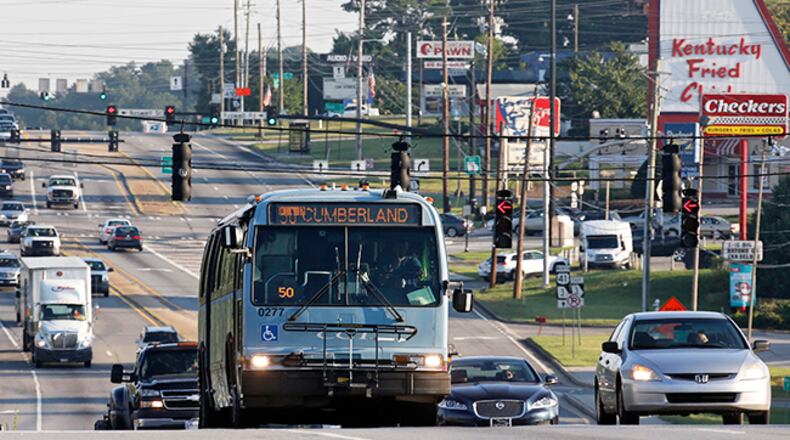The story so far:
The Atlanta Journal-Constitution has been following Cobb’s attempt to secure funding for bus rapid transit for the past year. The newspaper was the first to report that Cobb Commission Chairman Tim Lee wanted to include $70 million worth of transportation projects in the county’s 2016 SPLOST project list that would have count toward the county’s 51-percent share of the project, without labeling the projects as being related to BRT. The projects were subsequently removed. Lee then promised a public referendum if commissioners decided to move forward with the BRT project. The AJC then reported that commissioners approved a key transportation planning document under the assumption that it required the BRT referendum, when it did not. The commission has since passed a resolution saying they intend to allow the public to decide whether BRT is built. Then last month, the newspaper reported that there were incorrect statements in the BRT environmental study and a federal grant application that indicated the commission had “accepted” the project, when it has taken no vote on the issue and commissioners remain divided on the merits of the project.
Cobb County’s controversial plan to build a $500 million bus rapid transit system will not improve rush-hour traffic along heavily traveled U.S. 41 and could make congestion even worse, according to a key environmental study necessary for the county to qualify for a federal grant that would pay about half the cost.
The document, called an Environmental Assessment, was released in April and includes traffic modeling at five “representative” intersections along the corridor, which is home of two busy employment centers, Dobbins Air base, Lockheed-Martin, residential enclaves, WellStar Kennestone Hospital and the Braves new stadium with its mixed-use development.
That modeling gives letter grades on a scale of A to F, which relate to the amount of time motorists are delayed at the intersections. Unlike academic grades, this scale includes the letter “E,” which is a wait of 55-80 seconds. An “F” grade means a wait of more than 80 seconds.
The report shows the bus system would provide no relief to motorists if operated under 2012 traffic conditions, and that it likewise will not thin heavy congestion in 2040 — under assumptions of both high and medium growth rates between now and then.
In fact, grades at four of the intersections fell in 2040 to an F with rapid transit in place. Those intersections graded either “D” or “E” without bus rapid transit, known as BRT.
The highest grade any of the intersections received was a “D,” which means waits of 35-55 seconds.
Ron Sifen, a transit activist who talked about the issue during the public speaking portion of Tuesday’s commission meeting, called the project “ridiculous” in an interview.
“They want to spend half a billion dollars on a project that will make congestion worse,” Sifen said. “There are only two tables in the whole (153-page) report that compare building the project to not building it (in terms of congestion). And what’s the impact? Building it results in worse congestion than not building it.”
Cobb DOT Director Faye DiMassimo was provided several questions for this story in an email July 7. The newspaper emailed additional questions to her after Sifen’s presentation. The newspaper received no response.
But DiMassimo wrote a column for the local Marietta newspaper, published July 15, in which she said Sifen was applying “limited intersection-specific results to the overall project and corridor.” DiMassimo also wrote that BRT ridership estimates of between 17,000-18,000, coupled with additional road improvements, demonstrates “how the proposed project benefits the growing multi-modal transportation needs of Cobb residents, students, commuters and visitors.”
Sifen is not convinced.
“She can declare that BRT won’t make traffic worse, but they didn’t study it,” he said. “They’re the ones saying these intersections are representative. This is their analysis — it’s their numbers.”
Commission Chairman Tim Lee has been pushing for the project since 2012, when Cobb voters roundly rejected the regional SPLOST initiative that would have helped fund a $1 billion version of BRT. The environmental report details a long history of BRT studies, but fails to mention the T-SPLOST's 2-to-1 defeat.
Lee on Tuesday refused to talk to a reporter who approached him to discuss several topics, including BRT.
David Welden, a campaign manager for former commissioner Helen Goreham and who has served on several citizen committees studying transportation projects, said BRT has never been about thinning traffic.
“It’s about commercial development,” said Welden, who thinks the reversible toll lanes currently under construction on I-75 will do more to mitigate traffic on U.S. 41 than BRT. “Where there’s a little Army-Navy store right now will be a 17-story office tower, or a live-work-play development.
“Most of the substantial property owners are in the community improvement districts and the Chamber of Commerce. Follow the money, and you’ll see why they are so interested in this project.”
Commissioner Bob Ott agreed, saying BRT is “nothing more than a push for economic development.”
“There are people out there who want BRT, and there’s a lot of effort being made to move in a direction that will make it happen,” Ott said.
In addition to at least $500 million in start-up costs — which includes having a dedicated lane for rapid transit buses along 13 miles of the U.S. 41 corridor and building 13 new stations — the project will cost about $7 million a year in operations and maintenance.
Sifen said the operational costs alone should be enough to detour the county from building the project.
“Cobb County has a lot of transit needs,” Sifen said. “The BRT could increase Cobb County’s budget for transit by 50 percent, all by itself, just to upgrade already existing transit in one corridor. If we have other needs in other corridors, where will we get that money?”
About the Author
Keep Reading
The Latest
Featured




